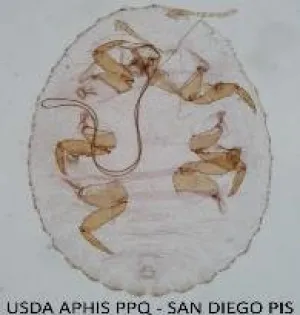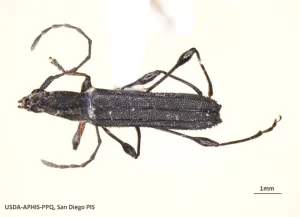SAN DIEGO – U.S. Customs and Border Protection agriculture specialists (CBPAS) at the Otay Mesa cargo crossing in San Diego intercepted two pests on two different occasions. Local U.S. Department of Agriculture (USDA) Animal and Plant Health Inspection Service (APHIS) Plant Protection and Quarantine (PPQ) identified them to be “First-in-Port” and “First-in-Nation.”
The most recent discovery was on June 22, when a shipment of rambutan fruit arrived at the Otay Mesa Cargo Facility. CBP officers referred the shipment for further agricultural inspection. During the inspection, a CBPAS discovered three specimens of Pseudococcidae. The specimens were submitted to local USDA APHIS PPQ and were then referred to a specialist for identification.
On June 24, the USDA APHIS PPQ specialist identified two of the three species of Pseudococcidae as actionable species Maconellicoccus hirsutus and Paraputo larai. They also confirmed the Paraputo larai as a “first-in-port” interception of this species. Many species of Pseudococcidae, also known as mealybugs, are considered pests as they feed on plant juices of plants and trees and act as a vector for several plant diseases. In recent years, some of the mealybug species have become invasive pests in localities posing a great problem to the new agro-ecosystems.
The second incident occurred on May 29, when a truck entered the U.S. from Mexico at the Otay Mesa Cargo Facility with a shipment of flowers. CBP officers referred the truck to the dock for agriculture inspection. A CBPAS conducting a hands-on inspection of the flowers found a live beetle on one of the flowers, a Cerambycidae on Solidaster sp. (CF). The specimen was submitted to the local USDA APHIS PPQ identifiers and then referred to a national specialist for identification.
On May 31, the pest was identified by the USDA APHIS PPQ national specialist as actionable Dihammaphora sp. (Cerambycidae) probably Dihammaphora hispida. Per local USDA APHIS PPQ, this qualifies as a “first-in-port” and "first-in-nation" interception for Dihammaphora hispida. All known longhorn beetle larvae feed on plant tissue such as stems, trunks, or roots of both herbaceous and woody plants, often in injured or weak trees. The larvae bore into wood, where they can cause widespread injury to either living trees or untreated lumber, causing extensive economic damage.
“I praise our CBP agriculture specialists for being vigilant and for preventing these pests from entering our beautiful country which could have caused a major economic disaster,” said Anne Maricich, CBP Deputy Director of Field Operations in San Diego. “Our CBP officers and agriculture specialists work diligently to fulfill CBP’s mission and protect our country from harm, including those hidden threats that could damage the U.S. agriculture, our natural resources and our economy.”
Both trucks and their shipments were returned to Mexico by CBP agriculture specialists as a precautionary measure.
CBP officers and agriculture specialists conduct examinations in the passenger and commercial environments to prevent harmful pests and diseases from becoming established in the U.S.



